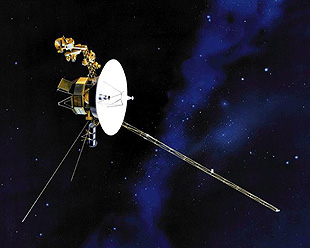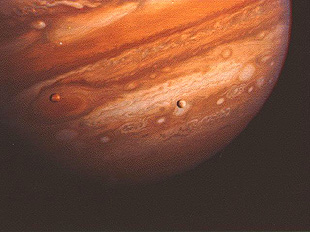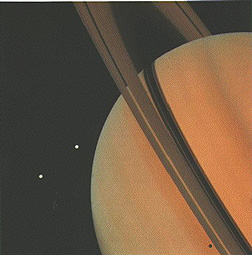Pioneer 11 passed Jupiter in December 1974 enroute to a flyby of Saturn in September of 1979; this spacecraft traversed Saturn's rings without being destroyed (as some predicted) by their (widely spaced) particles. Pioneer 11 also found evidence that Jupiter's magnetosphere extends beyond Saturn's orbit in the direction away from the Sun.
We come now to what is indisputably the most outstanding planetary space missions ever sent forth by mankind: the Voyager 1 and 2 probes to the outer planets. At a cost of under one billion dollars - a true bargain even then - all of the Giant planets, Jupiter, Saturn, Uranus, and Neptune were visited up close by two remarkable spacecraft which started their Grand Tours in 1977 and are still going strong as these vehicles leave the Solar System. All four planets and 48 satellites - some discovered by the Voyagers - were imaged. A thorough summary of the Voyager missions is offered on the Jet Propulsion Lab's (JPL) Voyager Home Page (http://vraptor.jpl.nasa.gov/voyager.html).
One impetus for the missions was the favorable conjunction of the Giant planets that occurs once every 175 years, such that initial trajectories plus corrections might allow at least one spacecraft to be guided past Jupiter all the way to Neptune. With each Jovian flyby, a gravitational "kick" was given to speed up the probe so as to favorably alter its course and shorten the travel time significantly (without this the trip to Neptune, at the initial launch velocities, would take 30 years).
Voyager 2 was fired off by rocket on August 20, 1977 to then arrive at Jupiter on March 5, 1979. Voyager 1 took off on September 5, 1977, reaching Jupiter on July 9, 1979. Even though leaving later, the shorter path followed by Voyager 1 permitted its earlier passing. Both then went by Saturn, 1 during November 1980 and 2 in August, 1981. The Voyagers had met the initial requirement of 5 years of operation but Voyager 1's chosen trajectory did not favor continuance to Uranus so it was allowed to depart upward (towards celestial north) out of the ecliptic. Voyager 2's "all systems go" status qualified it, with appropriate course corrections, to head to Uranus, encountering it on January 24, 1986. Further adjustment sent it on to Neptune, with closest approach on August 25, 1989. At each new rendezvous, everything worked in order. Both spacecraft have now left the planetary region of the solar system.
An artist's rendition of Voyager 1 travelling through space appears below. The scientific payload appears at its upper left and also on the large boom extending left to right.

The Voyagers carried instruments designed to support 10 experiments. In addition to TV cameras, others included UV and IR sensors, and cosmic-ray, plasma and charged particle detectors, and magnetometers (see the Voyager Home Page for a schematic drawing of the spacecraft with its deployed instruments; click on each for a functional description). Because of the ever-greater distance from the Sun, solar panels could not be used for power but radioisotope thermoelectric generators (RTGs) relied on decay of radioactive plutonium to convert heat into electricity. Even today, radio signals are still being received from the Voyagers, both now well beyond 100 A.U. (1 A.U. is the distance from Sun to Earth: 150 million kilometers [93,000,000 miles]) having reached past the heliopause, the outermost boundary of measurable solar wind.
As an introduction to the superb images sent back from the Voyagers, consider the next two views, each showing a segment of its planet, along with two visible moons. At the top is Jupiter, seen by Voyager 2 on February 3, 1979 from a distance of 20,000,000 km, with Io to the left and the moon, Europa, to its right. At the bottom is an image from Voyager 1 that displays part of the Saturnian surface, its magnificent rings (innermost = A, then the Cassini Gap, then B, the Encke Division, and C and the outer rings), and the moons Dione and Tethys.


The Giant planets are just that: vastly larger near-spherical bodies dominated by atmospheres that comprise the bulk of their volumes. Orbiting at 5.2 A.U., Jupiter is the largest - with equatorial diameter of 142,984 km (88,793 miles) (measured from center to an outer level where atmospheric pressure is estimated to be 1 atm.) and mass of 1.9 x 1027 kg (4.19 x 1027 pounds) (greater than 2x that of all other solar planets combined; 318x > Earth). Moving outward there is a successive diminishing of equatorial diameters as follows: Saturn (9.54 A.U.) - 120,530 km (74,849 miles); Uranus (19.22 A.U.) - 51,116 km (31,743 miles); Neptune (30.1 A.U.) - 49,528 km (30,757 miles); they experience polar flattening from about 2 to 10%. Each planet rotates very rapidly for its size: all have rotational periods less than 1 Earth day. All four planets consist mainly of hydrogen and helium (for Jupiter and Saturn, the ratio of H/He is about 9:1 by number of atoms and 4:1 by atomic weight); minor amounts of methane and ammonia, and traces of nitrogen and water. Jupiter and Saturn are massive enough to convert the inner layers of hydrogen into a metallic liquid state (for Jupiter this region is up to 40000 km [24840 miles]-thick; it is less than 15000 km [9315 miles] for Saturn) that grades outward into liquid molecular hydrogen (Jupiter ~ 18000 km (11180 miles)-thick), and then comparatively thin atmospheres. Metallic hydrogen is absent in Uranus and Neptune, the interiors being mostly molecular hydrogen. Based on density calculations, all four planet's are believed to have a rocky (silicate) core, subjected to high pressures and temperatures (Jupiter: ~ 20000° K). The radius of Jupiter's core is ~5% and Saturn's ~10% of the lengths of the planetary radius; the cores of Uranus and Neptune extend out to about 1/2 their planetary radius.
Thermal energy release from compression is largely responsible for the internal heat that makes each planet warmer at the surface (reverse thermal gradient) than expected from solar heating alone (for Jupiter, heat from the interior provides 70% more thermal energy than received from the Sun). This energy provides the fluid dynamics that drive the atmospheres into intense motions in belts or zones roughly parallel to their equators, with wind speeds far in excess of those attained on Earth. Thermal conditions at great depth give rise to electron stripping and other mechanisms involving conductive motions that produce magnetic fields around each planet; the fields of Jupiter and Saturn are about 4000 and 1000 times respectively that of Earth; those of Uranus and Neptune are much weaker. The magnetospheres of Uranus and Neptune have unusual shapes and distribution, with the magnetic pole axis of each strongly inclined to the rotational axis. Uranus's spin axis has been tilted 98° into a position approaching the solar ecliptic plane.
Prior to the Voyagers, only Saturn was known to have rings of material moving in near circular paths at varying distances beyond the planet's (gas pressure-defined) surface. But. as the three other planets were imaged, positive visual evidence of generally more subdued rings were found at each, so that rings are now considered the norm for this type of body. The rings consist of minute particles of ice and rock; at Saturn some are as large as a small house, that concentrate in orbital pathways only a few kilometers thick. Within the rings, the particles are actually separated by considerable space. The origin of such rings is still uncertain: opinion favors disruption of earlier satellites but collection of debris eroded from existing satellites or even capture from interplanetary space or "left overs" from the time of planetary accretion may play roles.
The satellites of the Giant Planets fall into two principal types: Larger ones adopt spherical shapes, assumed when their constituent materials are sufficiently "fluidized" to bring about gravitational equilibrium resulting in an equipotential surface. Smaller ones retain irregular shapes that suggest they have not been significantly altered by melting or that they are fragments from collisions that broke their parent body(s) apart. Some may have been captured from asteroid-like belts or from passing comets and other space debris. Most of the satellites are composed of mixtures of rock and ice (water, carbon dioxide, or other frozen gases). Ice is often the dominant material at the surface. The surfaces of many satellites show varying, often heavy, cratering that may be preserved states soon after they had formed. Some satellites have unusual, patchworklike multityped terrains that suggest they were reassembled from pieces torn apart from collision. Indications of later, partial melting are present at a few. One satellite has an atmosphere; several may contain liquids at or below their surfaces, and at least one has ongoing volcanic activity. All in all, there is a lot of commonality among the satellites, yet each retains its own distinctive "character".
Code 935, Goddard Space Flight Center, NASA
Written by: Nicholas M. Short, Sr. email: nmshort@epix.net
and
Jon Robinson email: Jon.W.Robinson.1@gsfc.nasa.gov
Webmaster: Bill Dickinson Jr. email: rstwebmaster@gsti.com
Web Production: Christiane Robinson, Terri Ho and Nannette Fekete
Updated: 1999.03.15.